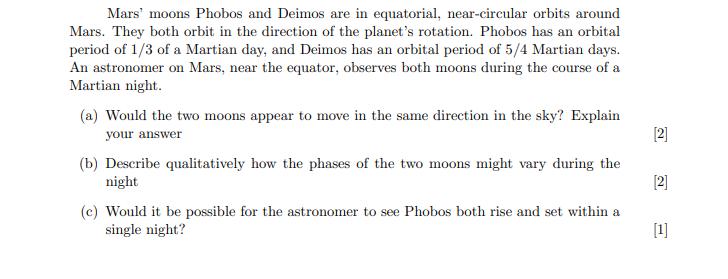Question
Mars' moons Phobos and Deimos are in equatorial, near-circular orbits around Mars. They both orbit in the direction of the planet's rotation. Phobos has

Mars' moons Phobos and Deimos are in equatorial, near-circular orbits around Mars. They both orbit in the direction of the planet's rotation. Phobos has an orbital period of 1/3 of a Martian day, and Deimos has an orbital period of 5/4 Martian days. An astronomer on Mars, near the equator, observes both moons during the course of a Martian night. (a) Would the two moons appear to move in the same direction in the sky? Explain your answer (b) Describe qualitatively how the phases of the two moons might vary during the night (c) Would it be possible for the astronomer to see Phobos both rise and set within a single night? [2] [2] [1]
Step by Step Solution
3.41 Rating (154 Votes )
There are 3 Steps involved in it
Step: 1
a Deimos would to rise appear in East set in w moving ve...
Get Instant Access to Expert-Tailored Solutions
See step-by-step solutions with expert insights and AI powered tools for academic success
Step: 2

Step: 3

Ace Your Homework with AI
Get the answers you need in no time with our AI-driven, step-by-step assistance
Get StartedRecommended Textbook for
Physics
Authors: James S. Walker
5th edition
978-0133498493, 9780321909107, 133498492, 0321909100, 978-0321976444
Students also viewed these Physics questions
Question
Answered: 1 week ago
Question
Answered: 1 week ago
Question
Answered: 1 week ago
Question
Answered: 1 week ago
Question
Answered: 1 week ago
Question
Answered: 1 week ago
Question
Answered: 1 week ago
Question
Answered: 1 week ago
Question
Answered: 1 week ago
Question
Answered: 1 week ago
Question
Answered: 1 week ago
Question
Answered: 1 week ago
Question
Answered: 1 week ago
Question
Answered: 1 week ago
Question
Answered: 1 week ago
Question
Answered: 1 week ago
Question
Answered: 1 week ago
Question
Answered: 1 week ago
Question
Answered: 1 week ago
Question
Answered: 1 week ago
Question
Answered: 1 week ago
View Answer in SolutionInn App



